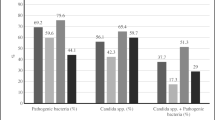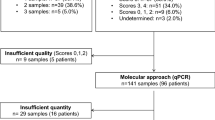Summary
A microbiological analysis of 102 patients suffering from cystic fibrosis was conducted over a 22 month period. 20 microbial species with the following incidence were identified:Pseudomonas aeruginosa: 83.4%;Candida albicans: 29.4%;Staphylococcus aureus: 24.5%;Staphylococcus epidermidis: 11.8%;Haemophilus influenzae: 11.8%;Streptococcus pneumoniae: 6.9%;Pseudomonas maltophilia: 6.8%;Aspergillus fumigatus: 5.9%. Other species were present in less than 5% of the patients. In the majority of specimens withP. aeruginosa, more than one type (up to six) was detectable. These strains were identical in colony appearance, O-serotype and pyocin-type. Quantitative analysis revealed concentrations of colony-forming units of 107 to 109 forP. aeruginosa, 106 to 108 forP. maltophilia, 104 to 107 forS. aureus, 104 to 106 forS. epidermidis and 104 to 107 forC. albicans in the majority of specimens. Significant differences were observed in the time periods during which the pathogens persisted in the patients. Maximum persistence was observed forP. aeruginosa. P. maltophilia andA. fumigatus had about similar persistence rates, which were lower than those forP. aeruginosa but above those forS. aureus andH. influenzae. S. epidermidis was eliminated within shorter periods thanS. aureus. C. albicans, although the second most frequent microorganism identified, showed a very low persistence rate. The microbiological analysis confirms results from other research centers (high incidence ofP. aeruginosa), but reveals significant regional differences as well (Pseudomonas cepacia not detectable, higher incidence ofP. maltophilia andC. albicans). This underlines the necessity for detailed qualitative and quantitative microbiological analysis of sputa from cystic fibrosis patients as a prerequisite for rational analysis of etiological, epidemiological and therapeutical aspects of cystic fibrosis.
Zusammenfassung
In Sputumproben von 102 Mukoviszidosepatienten konnten innerhalb von 22 Monaten insgesamt 20 verschiedene Mikroorganismenarten nachgewiesen werden. Ihr Auftreten verteilt sich wie folgt (in % der Patienten):Pseudomonas aeruginosa 83,4%,Candida albicans 29,4%,Staphylococcus aureus 24,5%,Staphylococcus epidermidis 11.8%,Haemophilus influenzae 11,8%,Streptococcus pneumoniae 6,9%,Pseudomonas maltophilia 6,8%,Aspergillus fumigatus 5,9%. Alle übrigen Spezies kamen in weniger als 5% der Patienten vor.Ps. aeruginosa trat überwiegend in mehreren Typen pro Patient auf (bis zu 6). Quantitative Unterschiede zwischen den Spezies wurden erkennbar: pro Gramm Sputum lagen die Koloniebildnerzahlen zwischen folgenden Grenzwerten:Ps. aeruginosa 107–109,Ps. maltophilia 106–108,S. aureus 104–107,S. epidermidis 104–106,Candida albicans 104–107. Der kontinuierliche Nachweis für einzelne Spezies und Typen im individuellen Patienten nahm in folgender Reihenfolge ab:Ps. aeruginosa, Ps. maltophilia, Aspergillus fumigatus, S. aureus, H. influenzae, S. epidermidis, Candida albicans. Diese Resultate deuten auf bemerkenswerte Unterschiede in der mikrobiologischen Konstellation verschiedener Zentren und Regionen bei Mukoviszidosepatienten hin und unterstreichen die Notwendigkeit für die Erhebung lokaler und individueller Daten als Grundlage für die Analytik von Ätiologie und Epidemiologie sowie rationale Chemotherapie bei Mukoviszidose.
Similar content being viewed by others
Literature
Di Sant'Agnese, P. A., Andersen, D. H. Celiac syndrome. IV. Chemotherapy in infections of the respiratory tract associated with cystic fibrosis of the pancreas; observations with penicillin and drugs of the sulfonamide group with special reference to penicillin aerosol. Am. J. Dis. Child. 72 (1946) 17–61.
Høiby, N. Microbiology of lung infections of cystic fibrosis patients. Acta Paediatr. Scand. Suppl. 301 (1982) 33–54.
Bauernfeind, A., Harms, K., Bertele, R. M., Petermüller, C., Przyklenk, B. Importance of Bacteriological Data for Antibiotic Therapy in Patients with Cystic Fibrosis. In:Simon, C., Wilkinson, P. (ed.): Diagnosis of infectious diseases — new aspects. Schattauer, Stuttgart, New York 1986, pp. 149–155.
Thomassen, M. J., Demko, C. A., Boxerbaum, B., Stern, R. C., Kuchenbrod, P. J. Multiple isolates ofPseudomonas aeruginosa with differing antimicrobial susceptibility patterns from patients with cystic fibrosis. J. Infect. Dis. 140 (1979) 873–880.
Hammerschlag, M. R., Harding, L., Macone, A., Smith, A. L., Goldmann, D. A. Bacteriology of Sputum in Cystic Fibrosis: Evaluation of Dithiothreitol as a Mucolytic Agent. J. Clin. Microbiol. 11 (1980) 552–557.
Wong, K., Roberts, M. C., Owens, L., Fife, M., Smith, A. L. Selective media for the quantitation of bacteria in cystic fibrosis sputum. Med. Microbiol. 7 (1984) 113–119.
Bauernfeind, A., Rotter, K., Pfister-Weisslein, Ch. Selective procedure to isolateHaemophilus influenzae from sputa with large quantities ofPseudomonas aeruginosa. Infection 15 (1987) 278–280.
Lennette, E. H., Balows, A., Hausler, W. J., Truant, J. Manual of Clinical Microbiology, Third Edition. American Society for Microbiology, Washington, D. C. (1980).
Ewing, W. (ed.): Identification of Enterobacteriaceae. Fourth Edition. Elsevier Science Publishing Co., Inc., New York 1986.
Schleifer, K. H., Kloos, W. E. A simple test system for the separation of staphylococci from micrococci. J. Clin. Microbiol. 1 (1975) 337–338.
Seeliger, H. P. R., Heymer, T. (ed.): Diagnostik pathogener Pilze des Menschen und seiner Umwelt. Georg Thieme Verlag, Stuttgart, New York 1981.
Fyfe, J. A. M., Harris, G., Govan, J. R. W. Revised Pyocin Typing Method forPseudomonas aeruginosa. J. Clin. Microbiol. 20 (1984) 47–50.
Huang, N. N., Doggett, R. G. Antibiotic Therapy of Pseudomonas Infection in Patients with Cystic Fibrosis. In:Doggett, R. G. (ed.):Pseudomonas aeruginosa — clinical manifestations of infection and current therapy. Academic Press, New York 1979, pp. 410–445.
Baltimore, R. S., Radnay-Baltimore, K., von Graevenitz, A., Bolan, T. F. Occurrence of nonfermentative gram-negative rods other thanPseudomonas aeruginosa in the respiratory tract of children with cystic fibrosis. Helv. Paediatr. Acta 37 (1982) 547–554.
Gilligan, P. H., Schidlow, D. V. Role ofPseudomonas cepacia in pulmonary disease of cystic fibrosis patients. Clin. Microbiol. Newsl. 6 (1984) 42–44.
Isles, A., Maclusky, I., Corey, M., Gold, R., Prober, C., Fleming, P., Levison, H. Pseudomonas cepacia infection in cystic fibrosis: an emerging problem. J. Pediatr. 104 (1984) 206–210.
Thomassen, M. J., Klinger, J. D., Badger, S. J., von Heeckesen, D. W., Stern, R. C. Culture of thoracotomy specimens confirm usefulness of sputum cultures in cystic fibrosis. J. Pediatr. 103 (1984) 352–356.
Govan, J. R. W., Harris, G. S. Technique for bacteriocin typing ofPseudomonas cepacia. In:Lawson, D. (ed.): Cystic fibrosis: Horizons. Wiley, New York 1985.
Corey, M., Allison, L., Prober, C., Levison, H. Sputum Bacteriology in patients with cystic fibrosis in a Toronto hospital during 1970–1981. J. Infect. Dis. 149 (1984) 283.
Schonheyder, H., Jensen, J., Høiby, N., Andersen, P., Koch, C. Frequency ofAspergillus fumigatus isolates and antibodies to Aspergillus antigens in cystic fibrosis. Acta path. microbiol. immunol. scand. Sect. B 93 (1985) 105–112.
Nelson, L. A., Callerame, M. L., Schwartz, R. H. Aspergillosis and atopy in cystic fibrosis. Am. Rev. Respir. Dis. 120 (1979) 863–873.
Laufer, P., Fink, J. N., Bruns, W. T., Unger, G. F., Kalbfleisch, J. H., Greenberger, P. A., Patterson, R. Allergic bronchopulmonary aspergillosis in cystic fibrosis. J. Allergy Clin. Immunol. 73 (1984) 44–48.
Bardana, E. J., Kasturi, L. S., Cianciulli, F. D., Noonan, M. J. Aspergillus antibody in patients with cystic fibrosis. Am. J. Dis. Child. 129 (1975) 1164–1167.
Brueton, M. J., Ormerod, L. P., Shah, K. J., Anderson, D. M. Allergic bronchopulmonary aspergillosis complicating cystic fibrosis in childhood. Arch. Dis. Child. 55 (1980) 348–353.
Staib, F., Abel, T., Mishra, S. K., Müller, J. A. Aspergillus fumigatus-Infektion der Lunge bei Mucoviscidose. Dtsch. Med. Wochenschr. 105 (1980) 442–445.
Iacocca, V. F., Sibinga, M. S., Barbero, G. J. Respiratory tract bacteriology in cystic fibrosis. Am. J. Dis. Child. 106 (1963) 315–324.
Govan, J. B. Pseudomonas aeruginosa and respiratory infection in cystic fibrosis. Cystic Fibrosis News. Focus on Research: Number 48 (1983) 5–9.
Høiby, N., Schiotz, P. O. (ed.): Pulmonary Infections in Cystic Fibrosis. Acta Paediatrica Scandinavica 301, 1982.
Govan, J. R. W., Doherty, C., Glass, S. Rational Parameters for Antibiotic Therapy in patients with Cystic Fibrosis. Infection 15 (1987) 300–307.
Ramphal, R., Vishwanath, S. Why is Pseudomonas the colonizer and why does it persist? Infection 15 (1987) 281–294.
Author information
Authors and Affiliations
Rights and permissions
About this article
Cite this article
Bauernfeind, A., Hörl, G., Jungwirth, R. et al. Qualitative and quantitative microbiological analysis of sputa of 102 patients with cystic fibrosis. Infection 15, 270–277 (1987). https://doi.org/10.1007/BF01644137
Issue Date:
DOI: https://doi.org/10.1007/BF01644137




